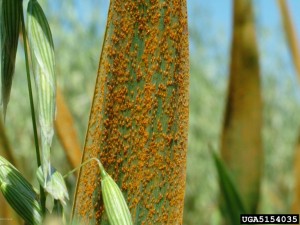 Dr. Ann Blount, Professor of Forage Breeding and Genetics provided the following very important update for winter forage producers.
Dr. Ann Blount, Professor of Forage Breeding and Genetics provided the following very important update for winter forage producers.We have a significant outbreak of Crown Rust on Oats state-wide in Florida. Last year, this new strain infected and killed most of our research oats at Quincy and Marianna. We have a new oat that we released this past fall that is currently resistant, however seed is of it is not yet on the market. ALL SOUTHEASTERN OATS appear to be susceptible to this new crown rust strain.
It would be advisable to let producers who planted oats be aware the need to scout their fields and be prepared to apply LEGAL fungicides if needed.
Producers who are growing oats for grazing might closely graze the oats to reduce the inoculant load. If it is feasible, they might consider overseeding with ryegrass to compensate for the production loss in forage. Still, if they overseed, the grazing animals will need to be removed to allow the ryegrass to establish.
Possibly, grazing oats could be treated with a fungicide after close grazing. Withdrawal restrictions must be followed as directed on the label. This may only temporarily arrest the rust, as inoculant appears wide-spread. Retreatment may add significant costs to winter forage production and economically, feeding conserved forages and supplements may be more cost effective.
For silage or seed oat, there are a number of LEGAL fungicides that may be effective. These include Headline, Proline, Stratego, Quadris, etc. Producers must follow labeled instructions for grazing withdrawal periods. Cheaper fungicides may be effective, like Tebuconazole, but do not list oats on their label and the label is the law. Only labeled fungicides can be recommended by the University of Florida. Multiple applications may be necessary for oats grown to silage or seed stage.

